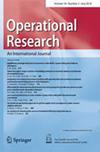单台机器上双部件作业的双标准制造调度
IF 2.7
4区 管理学
Q2 OPERATIONS RESEARCH & MANAGEMENT SCIENCE
引用次数: 0
摘要
摘要研究了单台加工机上n个作业的非抢占调度的双准则问题,每个作业都有一个交货期,由一个标准部件和一个特定部件组成,以同时最小化完工时间和最大延迟。特定组分单独加工,标准组分分组成批加工。在处理每批标准组件之前都需要一段设置时间。标准组件只有在它所属的批次完全完成时才可用(即准备好交付到下一个生产阶段),而特定组件在完成其加工后才可用。作业的完成时间定义为其两个组件都已处理并且可用的时刻。提出了一种时间为$$O(n^2\log n)$$ O (n2 log n)的线性存储算法,该算法可以生成所有Pareto最优点,并为每个Pareto最优点找到相应的Pareto最优调度。本文章由计算机程序翻译,如有差异,请以英文原文为准。
Bicriteria fabrication scheduling of two-component jobs on a single machine
Abstract This paper studies the bicriteria problem of non-preemptively scheduling n jobs, each of which is associated with a due date and comprises a standard and a specific component, on a single fabrication machine to minimize makespan and maximum lateness simultaneously. The specific components are processed individually and the standard components are grouped into batches for processing. A setup time is required before each batch of standard components is processed. A standard component is available (i.e., ready for delivery to the next production stage) only when the batch it belongs to is totally completed, whereas a specific component is available on completion of its processing. The completion time of a job is defined as the moment when both its two components have been processed and are available. An $$O(n^2\log n)$$ O ( n 2 log n ) -time algorithm with linear memory requirements is presented which can generate all Pareto optimal points and find a corresponding Pareto optimal schedule for each Pareto optimal point.
求助全文
通过发布文献求助,成功后即可免费获取论文全文。
去求助
来源期刊

Operational Research
OPERATIONS RESEARCH & MANAGEMENT SCIENCE-
CiteScore
5.70
自引率
3.70%
发文量
59
期刊介绍:
Operational Research · An International Journal (ORIJ) publishes high quality scientific papers that contribute significantly to the fields of operational research and management science (OR/MS). ORIJ covers all aspects of OR including optimization methods, decision theory, stochastic models, simulation, game theory, queueing systems, inventory and reliability, among others. ORIJ focuses on papers presenting new theoretical insights and developments as well as real-world case studies illustrating the implementation of OR approaches in practice. Papers exploring the interactions of OR/MS with other relevant disciplines such as information technology, computer science, artificial intelligence, soft computing and electronic services are of particular interest. This is a unique feature of ORIJ compared to other existing OR journals, providing the means to explore new directions in OR/MS research in a interdisciplinary context. Overview papers from eminent scientists in significant fields of OR/MS that review the state-of-the-art in these fields, are also welcome.
 求助内容:
求助内容: 应助结果提醒方式:
应助结果提醒方式:


